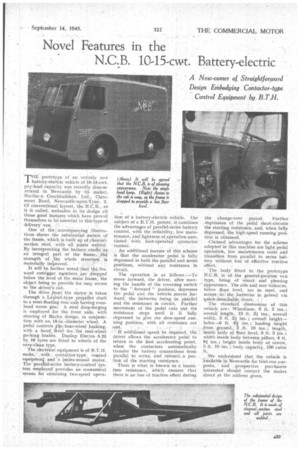Novel Features in the N.C.B. 10-15-cwt. Battery-electric
Page 25

If you've noticed an error in this article please click here to report it so we can fix it.
T"prototype of an entirely new battery-electric vehicle of 10-15-cwt. pay-load capacity was recently demonstrated in Newcastle by its maker, Northein Coachbuilders, Ltd., Clare-, mont Road, Newcastle-upon-Tyne, 2. Of Conventional layout, the N.C.B., as it is called, embodies in its design all those good features which have proved themselves to be essential to this type of delivery' van.
One of the accoMpanying illustrations shows the substantial .nature of the flan* which is built up of channelsection steel, with all joints welded. By incorporating the battery.. cradle. nk, an integral part of the franie.i:., the strength of the whole sitructure. is materially improved. • •
It will be further noted 'that the.forward outrigger members' are' dropped below the level of the, main frame, the object being to provide for easy access to the driver's cab.
The drive trorn' the motor is taken, through a Lqrnb-tYpe prOpelier shaft to a semi-floating rear axle having over-. head worm gear. A steel drop-forging is employed for the front axle, with steering of Maples design, in conjuneticm with an 18-in.-diameter wheel. A pedal controls 4the■ foun-wheel lara.king, with a hand levelfor. the 'rearwheel parking brakes. Dunlop Electra 5.25 by 10 tyres are fitted to wheels of the easy-clean type.
The electrical equipment is of B.T.H. make,' with contaCtor-type coiatrol equipment and 'a ',series-Wound motor. The parallel-series battery-control 'system employed provides an economical means for obtaining two-speed opera tion of a battery-electric vehicle. 'the subject of a B.T.H. patent, it combines the advantages of parallel-series battery control, with the reliability, low maintenance, and lightness of operation associated With foot-operated Ontactor control.
An additional feature of this scheme is that the accelerator pedal is fully depressed in both the parallel and series positions, without any resistance in circuit.
The operation is as follows:—To move forward, the driver, after moving the handle of the reversing 'switch to the "forward " position, depresses the pedal and. the Vehicle, moves .for ward, the :batteries being in paMllel and the resistance in cirettit. Further movement of the pedal cuts out the resistance steps until it i fully depressed to give the slow-speed running position; with all resistance cut If additional -speed,. be required,, 'the driver allows the accelerator pedal to return to the first accelerating point, when' the contactors automatically transfer the battery connections from parallel to series, and reinsert_ a portion of the Starting resistance.
There is what is known as a transition resistance, which ensures that there is no loss of tractive effort during the changeover period. Further depression of the, pedal short-circuits the starting resistance, and, when fully depressed, the high-speed running position is obtained.
Claimed advantages for the scheme adopted in this machine ate light pedal operation, low maintenance costs and transition from parallel to series battery without loss of effective tractive effort.
The body fitted to the prototype N.C.B. is of the general-purpose veal type, being of smart and pleasing appearance. The side and rear valances, below flopr level, are in. steel, and acCess._ to the battens is, gained via quick-detachable, doors. i
The stanclaild dimensions of this vehicle are: Wheelbase, 6 it. 3 ins. ; overall length, 12 ft. 21 ins., overall width, 5 ft. 2i ins. ; overall height laden-6 ft. of ; loading height ,from, ground;; 2 .ft. 10 ins.; length, inside bOdy at floor level, 8 ft. 5 ins. ; width inside body between pillars, 4 ft. 9i ins.; height inside body at centre, 3 ft. 10 ins:; body capacity, 150 cubic ft.
We upderstand that the vehicle is 'available in Newcastle for trial-run purposes, and prospective purchasers interested should contact the maker direct at the address given.




















































